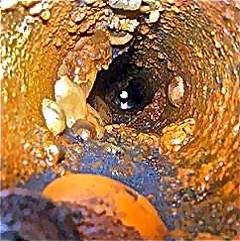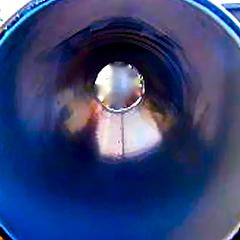August 10, 2014
Water Infrastructure in Japan: Toward an Age of Maintenance and Demolition
Keywords: Resilience Water


Copyright Junji Hashimoto All Rights Reserved.
The civil infrastructure in Japan was constructed some time ago, and is showing its age. While continuing with periodic inspections and maintenance, Japan will face a difficult decision regarding which infrastructure to keep and which to give up.
Junji Hashimoto, a water journalist, contributed this article to share his views about extending the service life of water infrastructure, one of the most important to support our daily life.
The Japanese Ministry of Land, Infrastructure, Transport and Tourism released on May 5, 2014, an action plan to extend the service life of civil infrastructure including roads, bridges, water supply systems and sewage systems. Japan constructed and made good use of its civil infrastructure, and is entering an age of maintenance to add more years to the infrastructure's service life. Soon, we will see an age of infrastructure demolition.
The current civil infrastructure in Japan was intensively constructed during Japan's period of rapid economic growth, the highlight of which was the 1964 Tokyo Olympics. It has been 40 to 50 years since then, and Tokyo will be hosting the Summer Olympics for the second time six years from now. As a result, we can argue that the current infrastructure well deserves complete replacement. However, that is not an easy task.
With the severe financial conditions and the decreasing population, Japanese civil infrastructure is definitely facing a different landscape than that of the rapid economic growth period. Not taking action now, however, will inevitably lead to accidents, which is why taking measures to manage infrastructure is essential.
At present, there are basically two things we should do to manage the infrastructure. One of them is inspection: assessing the present condition and performance of the existing infrastructure, and projecting its future condition. It is important to consider whether it is still serviceable, and if so, how many years could be added to its life by what repair work on which part. The other thing we have to do is maintenance, including repairs and replacements based on the inspection.
To use the public water system as a specific example, Japan has about 1,000 water pipeline ruptures and about 5,000 road cave-in accidents every year. Out of about 610,000 kilometers of water pipes running across the nation, roughly 38,000 kilometers of them have past their statutory useful life of 40 years. This distance is equivalent to one full lap around the earth and is growing longer. Replacement of pipelines costs 100 million to 200 million yen (about U.S.$970,000 to U.S.$1,940,000) per kilometer, which is not an option for many municipalities.
Under this situation, many municipalities started adopting strategies to extend the life of water pipes. Instead of replacing pipelines when their statutory useful lives expire, which is not feasible under the difficult financial circumstances, they are introducing new technologies such as applying anti-corrosion coatings inside the pipelines, and successfully extending their service life by 20 to 30 years.
In order to extend the life of pipelines, various technologies have been developed or are now under development. For example, inspection techniques now include using sonic waves or robots, and a pipeline renewal technique called the Sewage Pipe Renewal (SPR) method.
The SPR method makes it possible to renew decrepit pipelines of various kinds including sewage pipes, agricultural water pipes and industrial wastewater pipes without entailing open-cut replacement. A strip of rigid polyvinyl chloride is inserted into an old existing pipeline, forming a new pipe, and then backfill material is injected into the space between the new pipe and the existing pipe. This method can be applied to any pipeline regardless of its cross-sectional shape, without requiring excavation work. Moreover, the construction work can be done without stopping the water flow inside the pipe, reducing the impact on traffic and people's lives. Also, the construction period and cost are much less than the open-cut method.
These technologies for inspection, as well as for maintenance, repair and replacement, are still being developed. Future cooperation between the government, industry and academia is required to meet the demands for improved performance and low prices.
Even more of a challenge is decision-making. In light of the decreasing population, we have to decide which infrastructure to keep and which to give up.
Some people cannot stop pursuing the dream of rapid economic growth, which was rational when the nation was in a growth phase. But different decisions are now required of those of us who are now living in this phase of maturing, faced with declining birth rates, an aging and decreasing population, rural depopulation, and energy problems, among other issues.
Written by Junji Hashimoto, Water Journalist
Related
"JFS Newsletter"
- Fifth Contest to Award Excellent Environmental and Social Practices by Junior High, High School Students
- TMG Sewerage Bureau Aims to Make Tokyo a 'Smart Energy City'
- Learning from the Past: Traditional Flood Control Systems in Japan's Kofu Basin
- Yahaba Waterworks Supporters Workshop -- Citizens Decide on the Future of the Water Supply
- Arase Dam: Japan's First Dam Removal Project Underway
Related
"Popular Articles"
- Cabinet of Japan Decide to Make Full Use of Rainwater in Newly Constructed Buildings
- Japan Facing Water Shortages in Some Areas: 2010 Water Resources Report
- A Cup of Water Saving Children's Lives
- MOE Publishes Cases of Water Footprint Calculations to Visualize Water Use
- Japanese Technology to Help Address Global Water Problems


